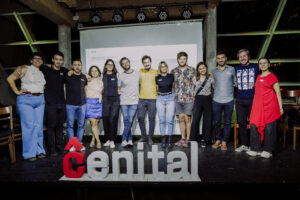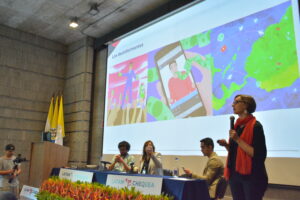
Group photo of the Cenital team. (Photo credit: Cenital)
Consolidating a sustainable journalistic project while conserving editorial independence is a difficult task and even more so in a context of daily inflation. The economy of the southernmost country of the continent is plunged into a fiscal deficit combined with a currency devaluation and an inflation that in 2022 reached 94.8%. The question is unavoidable: What strategies to raise funds do independent digital native media implement in order to survive? LatAm Journalism Review (LJR) talked to Cenital, Chequeado and elDiarioAr about their challenges and achievements in Argentina’s current context.
To survive, these news outlets combine several elements: Advertising walls on their websites, membership programs, course registrations, innovation, and international grants. But what underlies all of them is — financial transparency (accountability) with their audiences, open dialogue between journalists and the communities of readers that helps to renew their financial support, new content to attract different audiences, and innovation and technology projects. Crises stimulate new proposals, in this case, to beat the inflationary run. And the good news is that they succeed.
Cenital is a news outlet based on newsletters that provide analysis and context to understand the news. It was born in 2019, amid political and economic uncertainty, marked by the acquisition of more debt with the International Monetary Fund. But nothing cut short the initiative. "I think we Argentines are used to surfing through instability and that gives us a toughness in our skin that makes us do what we do despite everything," Agustina Gewerc, Cenital product manager, said.
Cenital's sustainability model is a mix of revenue: membership (42.4%), traditional private and public advertising (39.4%) and a small percentage of grants (17%). The challenge is to maintain this revenue and grow. Argentina's galloping inflationary crisis played a bad hand in 2022. Although that same year the number of subscribing members increased by 50%, the internal costs were higher than the income. To overcome this situation, they capitalized on circumstances and knew how to take advantage of them.
The World Cup in Qatar presented them with a great opportunity. The Cenital team got new online sponsors and launched the newsletter We went to the World Cup. "We got on board this Argentine mass event, through a more curated coverage and sought to reach people interested in the World Cup, but who did not know about Cenital," Gewerc told LJR. Today, the number of subscribers to all the newsletters reaches 60 thousand, and the number of members who contribute monthly exceeds 3,850.
Today, Cenital produces twelve daily, weekly and biweekly newsletters with topics ranging from books and sustainable development to politics and justice. "We send more than one and a half million emails a month, with an opening rate of 48.5%, when the market average is between 15% and 20%,” Ivan Schargrodsky, Cenital's CEO, wrote in an email he shared with his user base at the end of 2022. It was a sort of recruitment campaign that effectively brought a record number of new members to the news outlet, made aware by the balance sheet and the transparency of the numbers. "Financial health also speaks to the health of democracy, of diverse coverage, content and focus. That’s where we find opportunity. We must all coexist and respect each other," Gewerc said.

Emilia Delfino, center, journalist of ElDiarioAR, with Tamara Tenembaun and Martín Rodríguez at the Book Fair 2022. (Credit: David Fernández)
ElDiarioAR was born in 2020, in the heat of the pandemic and the third consecutive year of Argentina's economic downturn. It is a digital news outlet, founded by journalists who challenge viral misinformation and traditional news companies. "Today we have 1,200 members who contribute 30% of revenues. The other 70% comes from online advertising," Marcelo Franco, ElDiarioAR's managing editor, told LJR. Nearly one million users browse its website every month.
The management team is concerned about the acceleration of inflation in Argentina on a daily basis. "The increase in editorial costs is exponential, month after month it is a challenge. What we do is launch campaigns in which we ask our subscribers to bring in new members to improve income," Franco said. And he explains that, although they manage to sell advertising, they cannot increase rates due to the day-to-day inflationary rhythm.
The economic outlook in Argentina today is very challenging. And if we look back, it is not very different from what it was about six years ago during the government of Mauricio Macri (2015-2019). At that time, the situation was also worsening and doing so in a sustained manner. In an analysis article in the Ámbito Financiero newspaper, Argentina's gross external debt in those years grew by 76%. That came hand in hand with a contraction in the economy and an inflation that in 2019 increased to 49.7% year-over-year.
In that context, the media suffered not only because of the devaluation of the national currency, but also because of the transformation process of the newspaper industry promoted by the vertiginous inspiration of eight crucial changes, listed in an article by Association of Argentine Journalistic Businesses (ADEPA, by its Spanish acronym). Among these changes: The explosion of social videos, the diversification of audiences transformed into communities of readers, the consumption of news through subscriptions, and new product packages.
On the other hand, the political polarization of Argentine society around the governments of Macri and Cristina Kirchner opened the way for new media to emerge on the margins of those discourse disputes impacting large media conglomerates. In this context, ElDiarioAR emerged, inspired by its Spanish sibling ElDiarioES, in which the majority share of capital is in the hands of journalists. "In ElDiarioAR, our income aims to cover editorial expenses. We don’t have shareholders who expect an economic return or market rates," Franco said. And regarding inflation and the economic imbalance, he said: "Not a day has gone by without a crisis. We have faced and continue to face a headwind. But this is part of doing independent journalism."

Olivia Sohr speaks at a regional Chequeado event in 2022. (Photo credit: Chequeado)
Argentina is one of the countries in the region that distrusts news the most. A report published by Reuters Institute reveals that it is the country with the lowest trust index among six Latin American countries: Brazil (48%), Peru (41%), Chile (38%), Colombia and Mexico (37%) and, finally, Argentina (35%). Argentines' distrust of the news is also greater than the global average of 42%.
Chequeado is a digital news outlet that has become one of the world leaders in data and information verification. It was born in 2010 with the aim of disseminating verified information, checking public speeches and the circulation of misinformation.
From the start, one of its sources of income was international funding. It received support from the United Nations Democracy Fund (UNDEF) for its founding. "We had a conservative approach in our organization regarding growth. We try to secure funds and step on firmer ground as we move forward and grow," Olivia Sohr, director of impact and new initiatives, told LJR. Continued commitment to sustainability means that institutional growth keeps pace with the production of news content.
Chequeado’s funding model is made up of: International funding (40%), businesses (52%) and others, such as individuals, donations in kind and civil associations (8%). The latter, which includes membership, is one of the most challenging. "It is not easy to upgrade fees charged to members, due to the breakneck pace of inflation. It takes a constant back and forth with people in our base to update them, communicate with them and retain them," Sohr said. In the case of international grants, funds received in foreign currency have a major impact on the economy and expenses of the news outlet.
From the beginning, Chequeado prioritized the balance between news content and institutional growth. Today, 30 members of the team work in other areas that have nothing to do with news writing. These are: an education program, innovation, impact, and new initiatives. "All [our] programs carry out projects and actions aimed at the same mission: To improve the quality of public debate," Milena Rosenzvit, education coordinator, told LJR.
Transparency when communicating with readers crystallizes in the accountability page that Chequeado includes on its website. "The funds we receive are mainly used for our work teams because they are our most valuable asset and a decisive factor in guaranteeing the quality and impact of what we do," according to the institutional website.
Beyond the economic crises in countries like Argentina, recruitment and membership strategies are a focus of growth that goes hand in hand with the production of content of these independent digital natives. "We work with our membership and our community in mind. It is something that runs through us, it is a very transversal role," Gewerc, from Cenital, said. And that agreement between members and the news outlet means a shared economic responsibility between journalists and readers.
--
Contributor Soledad Dominguez is a journalist covering and writing stories on human rights, racial equality and innovation in journalism in Argentina and Brazil.